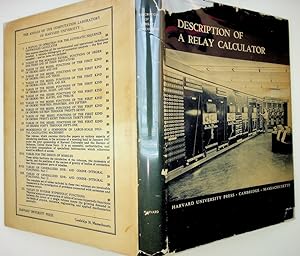Description Relay Calculator by Staff Computation Laboratory (2 results)
Search filters
Product Type
- All Product Types
- Books (2)
- Magazines & Periodicals (No further results match this refinement)
- Comics (No further results match this refinement)
- Sheet Music (No further results match this refinement)
- Art, Prints & Posters (No further results match this refinement)
- Photographs (No further results match this refinement)
- Maps (No further results match this refinement)
- Manuscripts & Paper Collectibles (No further results match this refinement)
Condition Learn more
- New (No further results match this refinement)
- As New, Fine or Near Fine (1)
- Very Good or Good (1)
- Fair or Poor (No further results match this refinement)
- As Described (No further results match this refinement)
Binding
- All Bindings
- Hardcover (2)
- Softcover (No further results match this refinement)
Collectible Attributes
- First Edition (1)
- Signed (No further results match this refinement)
- Dust Jacket (1)
- Seller-Supplied Images (1)
- Not Print on Demand (2)
Language (1)
Price
- Any Price
- Under US$ 25 (No further results match this refinement)
- US$ 25 to US$ 50 (No further results match this refinement)
- Over US$ 50
Free Shipping
- Free Shipping to U.S.A. (No further results match this refinement)
Seller Location
Seller Rating
-
DESCRIPTION OF A RELAY CALCULATOR (The Annals of the Computation Laboratory of Harvard University - Volume XXIV)
Published by Cambridge, Mass., Harvard University Press., 1949. [, 1949
Seller: Reiner Books, Minneapolis, MN, U.S.A.
Hardcover. Condition: Very Good. ] Hardback, quarto, appx 8 1/4 x 10 3/4 inches, gilt spine titling on dark blue cloth covers, xviii + 366 pages, Near or About VG/no dustjacket (stiff clear acetate dustwrapper will be provided to preserve condition ). Tight binding with hinges intact, spine titling partially rubbed (all still legible) o/w normal signs of wear not too bad (spine ends shallow shelf bumping, top corners barely rubbed through, lower corners a little worse). Small moisture sign adjacent heel of spine on f&b covers & a rather minor dribble down lower half of front joint. Interior quite nice throughout with only very small light moisture sign base of each hinge (f&b) and previous owner neat name stamp (George A. Hardenbergh) and signature (G.A. Hardenbergh) along top edge inside front cover. Prev owner not the easiest to google, but full name George Adams Hardenbergh, had been a collector of theater organs and, quoting one source (Greg Cosimini), George was an engineer from way back and worked for Univac on the really old computers. Due to size and weight International order will require additional shipping charges. RWR5 Science Technology Electrical Engineering Electronics History of Computers.
-
Description of a Relay Calculator
Published by Harvard University Press, Cambridge, Massachusetts, 1949
Seller: Kuenzig Books ( ABAA / ILAB ), Topsfield, MA, U.S.A.
First Edition
Cloth. Condition: Near Fine. Dust Jacket Condition: Fair. First Edition. First Edition. xvi, [2], 336 pages. 4to [10 3/4 x 8 3/8 inches]. Publisher's blue cloth. The rare dust jacket is present, albeit chipped, stained, and worn (especially at foredges). Bright and clean internally. Cloth. "The electromechanical Harvard Mark I was the first programmable calculating machine to actually produce mathematical tables, fulfilling the dream of Charles Babbage originally set out in print in 1822." (OOC, #411) "The manual for the Harvard Mark II, a relay-based calculator built for the navy during the last year of World War II. It was installed at the Naval Proving Ground in Dahlgren, Virginia, in 1948, where it was used mainly for the development of ballistics tables. The Mark II's design did not depart radically from that of its predecessor in that it employed electromechanical equipment and was programmed via paper tapes, 'but otherwise it was very different. Where the Mark I used rotary mechanical systems (with magnetic clutches) for storing numbers, the Mark II used relays. The way of programming it was very different (i.e. the instruction set was different). The fact that it was essentially two machines which could be combined for large jobs or have each half running independent jobs was quite different.' (MRW Other innovations included a floating decimal point and a new type of relay. It was considerably faster than the Mark I . The Manual for the Harvard Mark II calculator was written primarily by Grace Hopper, assisted by Constance K. Rawson, Peter O. Cioffi and Richard D. Woltman. It was completed by Charles H. Richards and K. B. Mitchell" (OOC) Volume XXIV of the Annals of the Computation Laboratory of Harvard University. All volumes in the series were heavily used, and finding copies in dust jacket is getting difficult. Literature: Hook and Norman, Origins of Cyberspace, #416, 411 (referring to Mark I).



